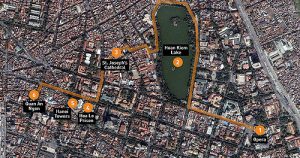I would still love to develop a project based on the Slave Trade and primary sources; however, the plan has evolved significantly since my last update. In fact, it changed so much that I’ve redesigned entirely. In part, this is because I’ve had two important meetings this week with teachers with whom I am collaborating. Although the project has gone in a different direction, it is perhaps even better and certainly more tightly focused. The new topic, title, and digital project page?
Power of Persuasion: The Language and Legacy of Elizabeth I
Below find a description of the project’s different digital components. It’s a great mix of sources, learning styles, assessments, I believe it also fosters interdisciplinary learning and “uncoverage” as Dr. Calder would say. There is still much to be figured and fleshed out, but I think the foundation and framework is solid, and I feel more grounded as well. Project components will be completed throughout the year, one per quarter. I will enter and upload primary sources with Dublin Core data, instructions, and other miscellaneous items by the end of this summer term.
Short Description
This project seeks to explore primary sources related to Elizabeth I. The types of sources are divided into three spheres that consider audience, scope, purpose, and meaning.
Private (letters)
Public (speeches)
Image (portraits/photography)
Projects/Activities
1. Transcription: Read primary sources and transcribe. Then, compare student transcription to published transcription. Harkness discussion on process and discrepancies. Student write blog reflection, which will form the basis of an Omeka collection and/or exhibit.
2. Rhetorical analysis: Read letters/speeches and analyze the use of logos/ethos/pathos, and the Ciceronian order of arguments. The final product will be an essay, which will form the basis of an Omeka collection and exhibit. Student will input Dublin Core data for proper citation and scholarship.
3. Image analysis: Make a podcast of a detailed “text” analysis of a painting of Elizabeth. Four portraits, students make podcasts in groups of four, each group discusses a different portrait. Podcasts will be represented as a collection and exhibit in Omeka.
4. Modern Female Politician: Pick a 20th or 21st century woman in politics and read a private source, a public source, and analyze an image. Present findings of analysis via oral presentation with Google Slides. Presentation files will form the basis of an exhibit in Omeka.
Primary Sources
Private (letters):
- (image) Dedication of french translation for Katherine Parr: http://www.bodley.ox.ac.uk/dept/scwmss/wmss/online/medieval/cherry/cherry.html
- (Working on image) 1549 Letter to protector about governess: http://www.luminarium.org/renlit/elizsomerset.htm
- (Image) Letter to brother (King Edward) when he was dying, with original image: http://www.luminarium.org/renlit/elizedward6.htm
- (Image) Tide Letter: http://www.luminarium.org/renlit/elizlet4.htm
Public (Speeches):
- Tilbury Speech: http://www.luminarium.org/renlit/tilbury.htm
- Speech on religion: http://www.luminarium.org/renlit/elizspeechreligion.htm
- Speech on marriage: http://www.luminarium.org/renlit/responseparl1559.htm
- (image) Speech on succession and marriage: http://www.luminarium.org/renlit/elizaspeech1563.htm
Image (portraits): Below find links four portraits completed during Elizabeth I’s life. At the bottom of the page you can navigate between three pages of portraits.
- Pelican portrait
- Ermine Portrait
- Armada Portrait
- Rainbow Portrait
My audience will still be high school students, as stated earlier — but the A.P. Language will tie in with more World History courses rather than U.S. history. However, there is still a U.S. component as part of the final assignment.
I’ve started an Omeka site with one small problem. I love the theme, but when I started adding items — a large “hero image” appeared on the homepage and I see no option to disable it. It throws off the formatting of the rest of the page. Perhaps Dr. Kelly can help, and I’ve also emailed Omeka.

